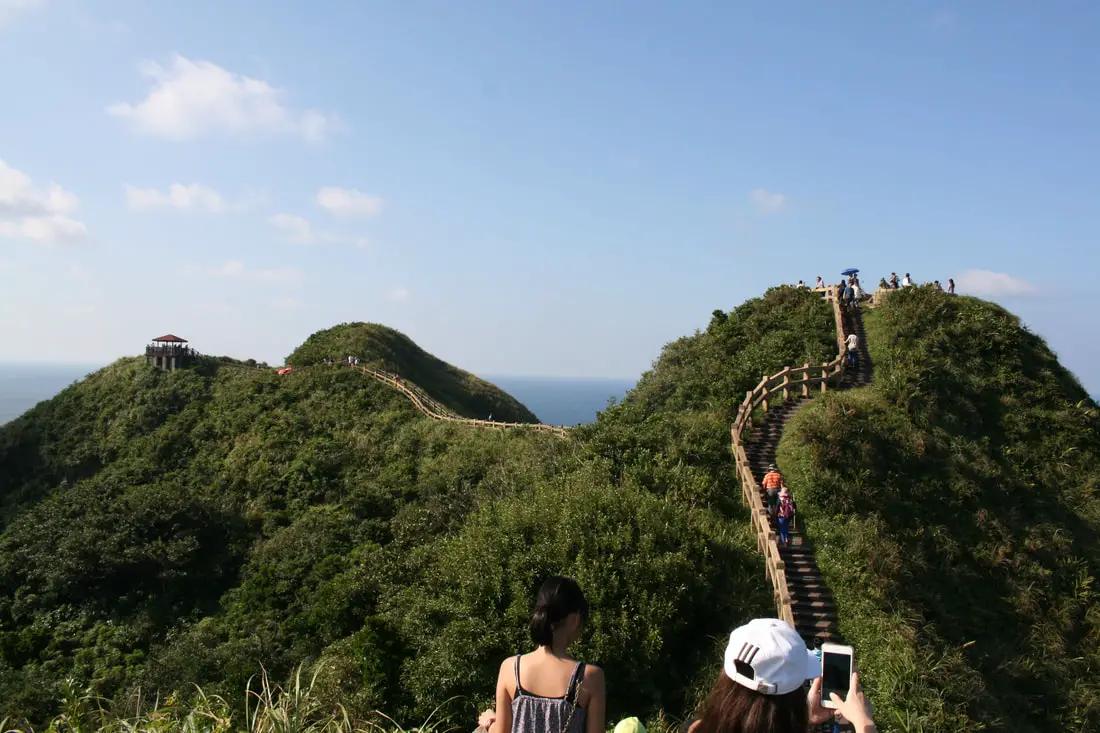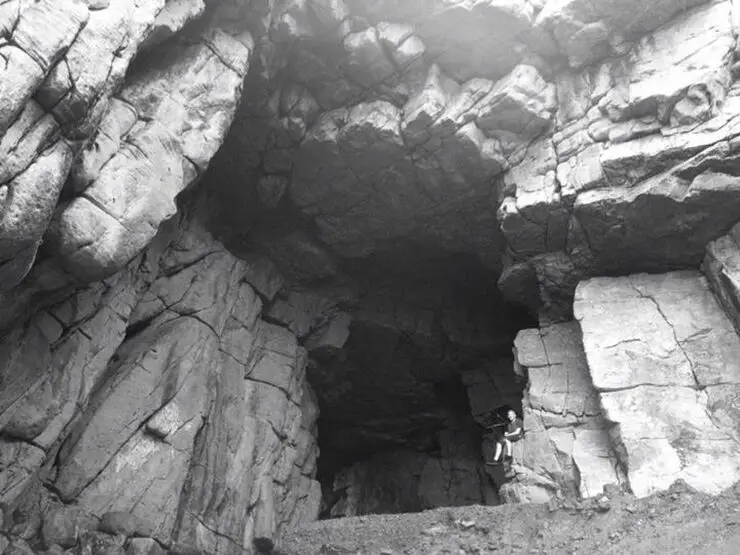|
Bitou Cape (aka Bitoujiao/Bítóujiǎo) is a scenic area of coastline in Ruifang District of New Taipei, along the northeast coast, with popular hiking trails, interesting geological formations, a refurbished tourist military complex. and steep sea cliffs. It is a beautiful area along the coast that you should be sure to not miss.
Background: The sandstone that forms Bitou Cape was formed as sediment under the ocean millions of years ago and were then uplifted thanks to the collision of the Eurasian and Philippine plates. The rocks are mainly sedimentary and are part of the same formation that forms the special rock formations on the northern coast around Keelung. Because of this, there are many interesting eroded rock formations around the cape. The name Bitou (鼻頭) means the tip of the nose in Chinese. Bitoujiao Lighthouse was completed in 1897, built by the Japanese. Later it was repaired in WWII, and is still used today. The ROC army/navy military base at Bitou Cape has been sitting dormant for over 20 years, and was finally opened to the public as a rainbow "pink" military base to attract tourists on May 1st, 2020. The area is a popular weekend destination for many residents of Northern Taiwan. Hours: 24/7 Price: Free Tours: You can book a tour to Bitou Cape on KKday here or Klook here. Activities along Taiwan's Northern Coast: Don't forget that there are many activities available along Taiwan's Northern Coast such as Wakeboarding, Surfing, Speedboat Surfing, SUP / Paddle Boarding, Diving, Snorkeling Kayaking, Canoeing, Water Biking, River Tracing / Canyoneering, ATVing, Horse Riding, Archery, Tree Climbing, Glamping, Motorcycling, Motorbike Tour, Dragon Boat Racing, Shen'ao Rail Bike, and more on Tripadvisor here, Klook here, or KKday here. Hotels on Taiwan's Northern Coast: We recommend Fullon Hotel which has locations in Tamsui and Fulong near the beach (book on Booking.com here, Tripadvisor here, Agoda here, or Hotels.com here). We have stayed at and recommend Gold Mountain Ranch, which is a horse ranch and glamping destination in Jinshan. You can book a night at Gold Mountain Ranch on Klook here. You can also check out our full blog on the ranch here. We have also stayed at and recommend Hai Xia Your Home which is right in front of Fulong Beach (book on Booking.com here, Tripadvisor here, Agoda here, or Hotels.com here). Looking for a hotel? We recommend booking through Booking.com here, which provides the best quality selection of accommodation in Taiwan. Find out where to stay in our Taiwan hotels guide or search for the best hotel deals in Taiwan here. How to get there: By Car/Scooter: From Keelung, take provincial highway 2 east along the north coast until you reach the Bitou Fishing Harbor. There is limited parking near the harbor, and further free parking on the other side of the tunnel but it is a bit of a walk. If you are looking for car rentals, you can also search Qeeq here, Klook here, or KKday here. You can also check out our car rental guide here. Looking for scooter rental in northern Taiwan? You can search on Klook here or KKday here to search for options. You can also check out our scooter rental guide here. By Bus: From Keelung TRA Station, take Keelung Bus 791 east about two hours to Bitou cape. You can purchase a discount easy card to use on the MRT and buses from Klook here or KKday here. You can also book an MRT travel pass on Klook here. By Bicycle: Cycling is the best way to enjoy Taiwan's landscapes if you have the time and energy. Looking for bicycle rentals in Taiwan? You can use Taiwan's many Youbike sharing stations, or search for rentals on KKday here, and search for tours on Klook here. You can also check out our Taiwan cycling guide here. You can also book a cycling tour on TripAdvisor here. For more information, check out our Taiwan transportation guide here. Map: Please see below:
0 Comments
Longdong (aka Dragon Caves -龍洞 Lóngdòng) is a popular spot for snorkeling, scuba diving, and rock climbing. There is also a large sea cave there (pictured above) from where the place gets its name.
Background: The sandstone that forms Longdong was formed as sediment under the ocean millions of years ago and were then uplifted thanks to the collision of the Eurasian and Philippine plates. The rocks are mainly sedimentary and are part of the same formation that forms the special rock formations on the northern coast around Keelung. Because of this, there are many interesting eroded rock formations around the cape. The name Longdong (龍洞 Lóngdòng) means dragon cave in Chinese, named after the prominent cave in the area. The area is a popular weekend destination for many residents of Northern Taiwan. Hours: 24/7 Price: Free Tours and Activities: You can book activities at Longdong such as Rock Climbing, Cave Draping, Diving, Snorkeling, SUPing, Freediving, and more on Klook here or KKday here. How to get there: By Car/Scooter: From Keelung, take provincial highway 2 east along the north coast until you reach the Longdong. There is limited parking near the harbor, and further free parking farther away. If you are looking for car rentals, you can also search Qeeq here, Klook here, or KKday here. You can also check out our car rental guide here. Looking for scooter rental in northern Taiwan? You can search on Klook here or KKday here to search for options. You can also check out our scooter rental guide here. By Bus: From Keelung TRA Station, take Keelung Bus 791 east about two hours to Longdong. You can purchase a discount easy card to use on the MRT and buses from Klook here or KKday here. You can also book an MRT travel pass on Klook here. By Bicycle: Cycling is the best way to enjoy Taiwan's landscapes if you have the time and energy. Looking for bicycle rentals in Taiwan? You can use Taiwan's many Youbike sharing stations, or search for rentals on KKday here, and search for tours on Klook here. You can also check out our Taiwan cycling guide here. You can also book a cycling tour on TripAdvisor here. For more information, check out our Taiwan transportation guide here. Map: Please see below: |
Author 作家I am an American expat who has extensive experience living, working, and traveling in Taiwan. In my day, I had to learn many things about Taiwan the hard way. But I have come to learn that Taiwan is one of the best places in the world for Foreigners to live. This blog does not represent the opinions of every foreigner in Taiwan. I am just trying to help others learn more about this beautiful country. Categories
|




 RSS Feed
RSS Feed
